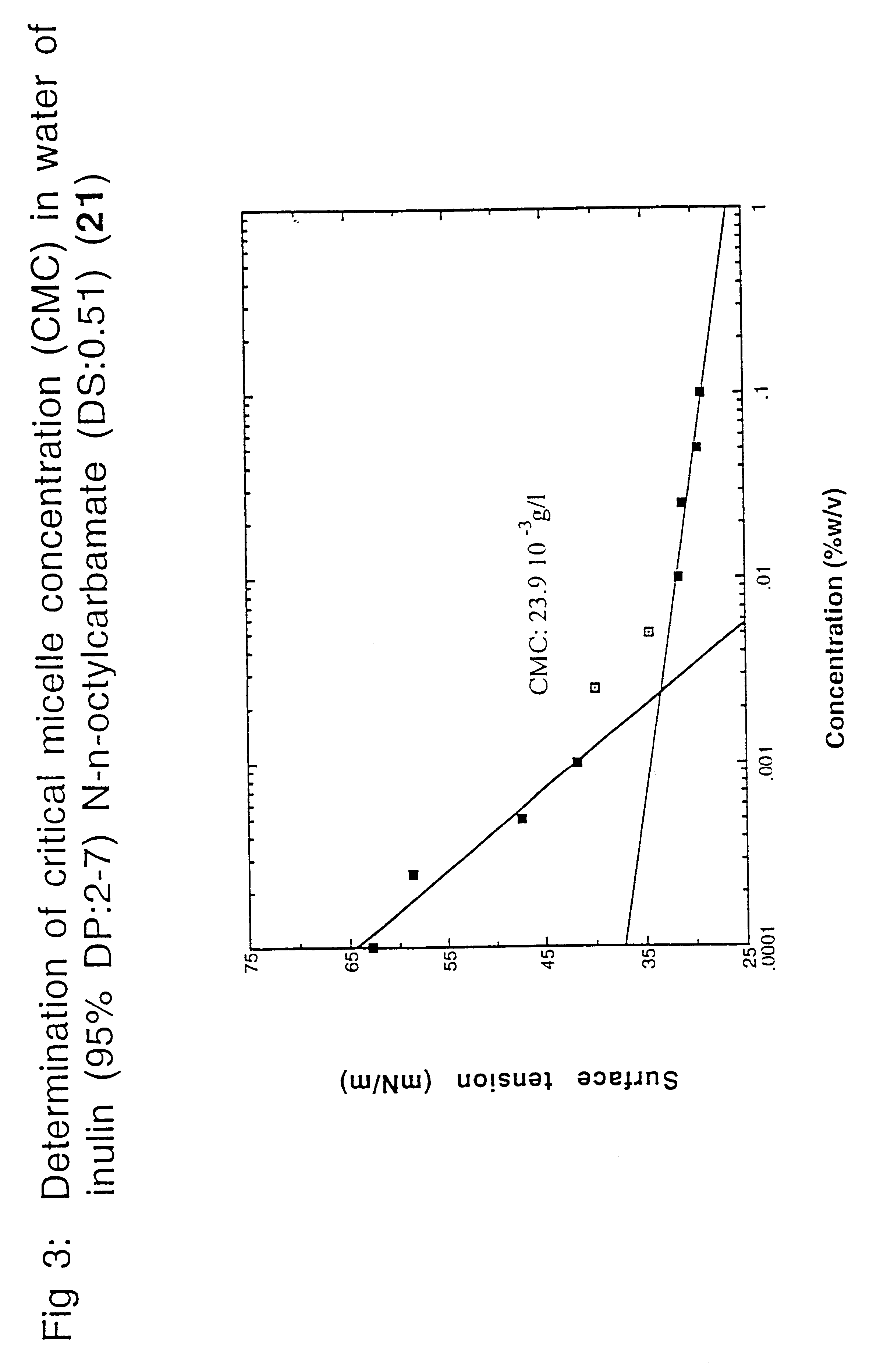Surface-active alkylurethanes of fructans
a technology of surface-active alkylurethanes and fructans, which is applied in the preparation of sugar derivatives, esterified saccharide compounds, and sugar derivatives, etc., can solve the problems of moderate to poor tensio-active properties of sucrose n-alkylurethanes with longer alkyl chains, and poor solubility of water. , to achieve the effect of good tensio-active properties,
- Summary
- Abstract
- Description
- Claims
- Application Information
AI Technical Summary
Benefits of technology
Problems solved by technology
Method used
Image
Examples
example 1
Inulin N-n-octylcarbamate (1)
In a 100 ml flask, 5.0 g inulin (RAFTILINE.RTM. HP with a (DP) of about 25; 27.7 millimole fructose equivalents) were dissolved under stirring at about 70.degree. C. in 8 ml dry DMF. To the yellowish solution 2.9 ml n-octylisocyanate (16.7 millimole; 0.6 mole equivalents determined on fructose units) were added dropwise with stirring at 70.degree. C. Stirring was continued for 24 hours at 70.degree. C. Then, after cooling, most of the DMF was evaporated under reduced pressure (.+-.6.7 Pa; 0.05 mm Hg). To the residue at room temperature, 10 ml of dry diethyl ether was added under stirring and the mixture was stirred for 1 hour. The white precipitate formed was isolated by filtration, washed with 15 ml dry ether and the residual solvents (DMF and ether) were removed under reduced pressure (.+-.6.7 Pa; 0.05 mm Hg), yielding inulin N-n-octyl-carbamate (1) with a degree of substitution (DS) of 0.56 (determined by .sup.1 H-NMR--270 MHz). Compound (1) was obtai...
example 2
Inulin N-n-octylcarbamate (2)
In a 500 ml flask, 33.3 g inulin (RAFTILINE.RTM. HP with a (DP) of about 25; 0.185 mole fructose equivalents) was dissolved at 60.degree. C. in 60 ml dry DMF. To the yellowish solution kept at 60.degree. C., 19.56 ml n-octylisocyanate (0.111 mole; 0.6 equivalents determined on fructose units) was added dropwise under stirring. Then the mixture was heated to 70.degree. C. and stirred for 24 hours. After cooling to room temperature, 150 ml diethyl ether was added slowly under vigorous stirring. After stopping the stirring, the reaction product quickly settled and most of the solvent was removed by decantation. Under stirring 100 ml dry ether was added to the residue, which became gummy-like. After addition of another 50 ml ether the residue started to granulate and after 1 hour stirring a white suspension was formed. The precipitated solid was filtered off, washed with dry ether and dried under reduced pressure (.+-.6.7 Pa; 0.05 mm Hg), yielding inulin N-n...
example 3
Biodegradability
The alkylurethanes (I) are well biodegradable. To illustrate said characteristic, the Biological Oxygen Demand (BOD) and Chemical Oxygen Demand (COD) for some inulin N-n-octylalkylcarbamates, measured by the Sapromat method, are given below:
PUM
| Property | Measurement | Unit |
|---|---|---|
| Mass | aaaaa | aaaaa |
| Fraction | aaaaa | aaaaa |
| Fraction | aaaaa | aaaaa |
Abstract
Description
Claims
Application Information
 Login to View More
Login to View More - R&D
- Intellectual Property
- Life Sciences
- Materials
- Tech Scout
- Unparalleled Data Quality
- Higher Quality Content
- 60% Fewer Hallucinations
Browse by: Latest US Patents, China's latest patents, Technical Efficacy Thesaurus, Application Domain, Technology Topic, Popular Technical Reports.
© 2025 PatSnap. All rights reserved.Legal|Privacy policy|Modern Slavery Act Transparency Statement|Sitemap|About US| Contact US: help@patsnap.com



